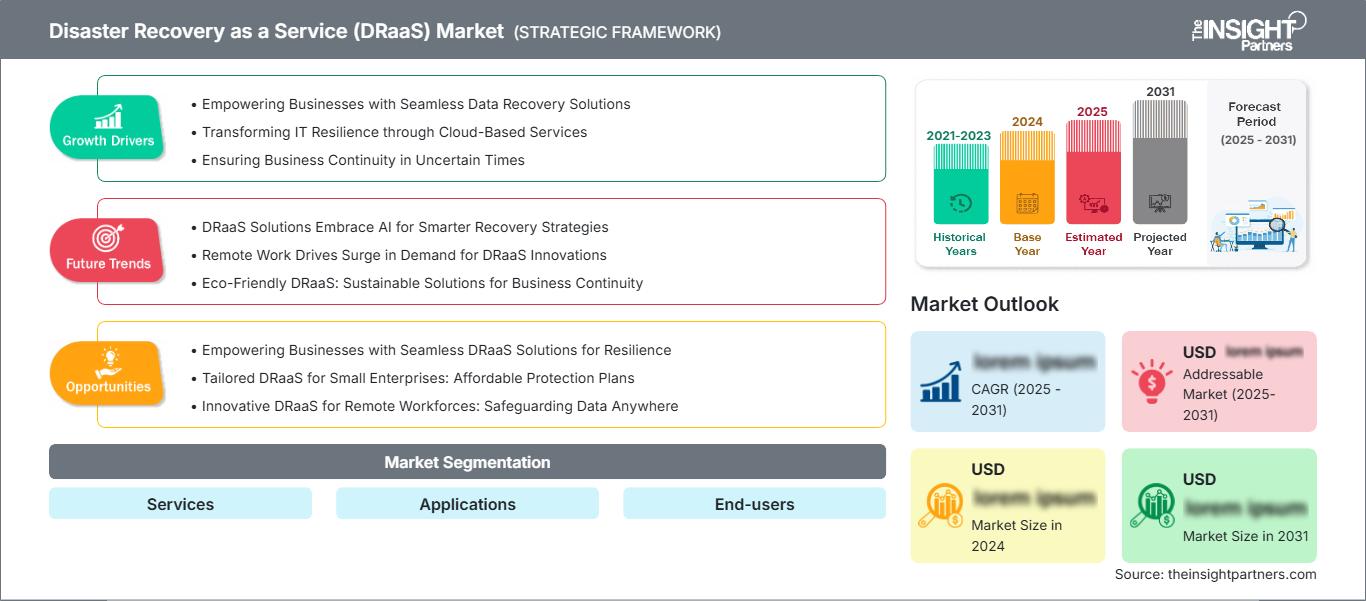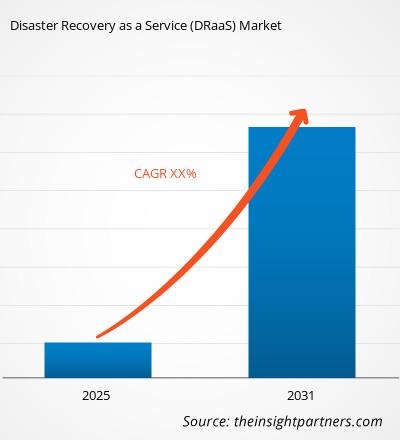Le marché de la reprise après sinistre en tant que service (DRaaS) devrait atteindre 73,85 milliards de dollars américains d'ici 2031. Ce marché devrait enregistrer un TCAC de 23,9 % entre 2025 et 2031.
Ce rapport est structuré par services et analyse le marché en fonction des applications. Il examine également le marché par utilisateurs finaux. Une ventilation détaillée est fournie aux niveaux mondial, régional et national pour chacun de ces segments clés. Le rapport inclut la taille du marché et les prévisions pour tous les segments, exprimées en dollars américains. Il fournit également des statistiques clés sur la situation actuelle des principaux acteurs du marché, ainsi que des informations sur les tendances actuelles et les opportunités émergentes.
Objectif du rapport
Le rapport sur le marché de la reprise après sinistre en tant que service (DRaaS) de The Insight Partners vise à décrire le paysage actuel et la croissance future, les principaux facteurs de croissance, les défis et les opportunités. Cela permettra d'éclairer divers acteurs du marché, tels que :
- Fournisseurs de technologies/Fabricants : Pour comprendre l'évolution de la dynamique du marché et identifier les opportunités de croissance potentielles, afin de prendre des décisions stratégiques éclairées.
- Investisseurs : Pour réaliser une analyse approfondie des tendances concernant le taux de croissance du marché, les projections financières et les opportunités tout au long de la chaîne de valeur.
- Organismes de réglementation : Pour encadrer les politiques et les activités du marché afin de minimiser les abus, préserver la confiance des investisseurs et garantir l'intégrité et la stabilité du marché.
Segmentation du marché de la reprise après sinistre en tant que service (DRaaS)
Applications
Utilisateurs finaux
Vous bénéficierez d’une personnalisation sur n’importe quel rapport - gratuitement - y compris des parties de ce rapport, ou une analyse au niveau du pays, un pack de données Excel, ainsi que de profiter d’offres exceptionnelles et de réductions pour les start-ups et les universités
Marché de la reprise après sinistre en tant que service (DRaaS): Perspectives stratégiques

- Obtenez les principales tendances clés du marché de ce rapport.Cet échantillon GRATUIT comprendra une analyse de données, allant des tendances du marché aux estimations et prévisions.
Facteurs de croissance du marché de la reprise après sinistre en tant que service (DRaaS)
- Offrir aux entreprises des solutions de récupération de données transparentes
- Transformer la résilience informatique grâce aux services cloud
- Garantir la continuité des activités en période d'incertitude
Tendances futures du marché de la reprise après sinistre en tant que service (DRaaS)
- Les solutions DRaaS intègrent l'IA pour des stratégies de reprise plus intelligentes
- Le télétravail stimule la demande d'innovations DRaaS
- DRaaS écologique : des solutions durables pour la continuité des activités
Opportunités du marché de la reprise après sinistre en tant que service (DRaaS)
- Offrir aux entreprises des solutions DRaaS transparentes pour une meilleure résilience
- DRaaS sur mesure pour les petites entreprises : Plans de protection abordables
- Solution DRaaS innovante pour les télétravailleurs : protégez vos données où que vous soyez
Marché de la reprise après sinistre en tant que service (DRaaS)
Les analystes de The Insight Partners ont analysé en détail les tendances régionales et les facteurs influençant le marché de la reprise après sinistre en tant que service (DRaaS) tout au long de la période prévisionnelle. Cette section aborde également les segments et la répartition géographique du marché de la gestion des troubles du rythme cardiaque en Amérique du Nord, en Europe, en Asie-Pacifique, au Moyen-Orient et en Afrique, ainsi qu'en Amérique du Sud et centrale.
Portée du rapport de marché sur la reprise après sinistre en tant que service (DRaaS)
| Attribut de rapport | Détails |
|---|---|
| Taille du marché en 2024 | US$ XX Billion |
| Taille du marché par 2031 | US$ 73.85 Billion |
| TCAC mondial (2025 - 2031) | 23.9% |
| Données historiques | 2021-2023 |
| Période de prévision | 2025-2031 |
| Segments couverts |
By Services |
| Régions et pays couverts | Amérique du Nord
|
| Leaders du marché et profils d'entreprises clés |
|
Densité des acteurs du marché de la reprise après sinistre en tant que service (DRaaS) : comprendre son impact sur la dynamique des entreprises
Le marché des solutions de reprise après sinistre en tant que service (DRaaS) connaît une croissance rapide, portée par la demande croissante des utilisateurs finaux. Cette croissance est notamment due à l'évolution des préférences des consommateurs, aux progrès technologiques et à une meilleure connaissance des avantages du produit. Face à cette demande croissante, les entreprises élargissent leur offre, innovent pour répondre aux besoins des consommateurs et tirent parti des tendances émergentes, ce qui stimule davantage la croissance du marché.

- Obtenez le Marché de la reprise après sinistre en tant que service (DRaaS) Aperçu des principaux acteurs clés
Points clés de vente
- Couverture exhaustive : Ce rapport analyse en détail les produits, services, types et utilisateurs finaux du marché de la reprise après sinistre en tant que service (DRaaS), offrant ainsi une vision globale.
- Analyse d'experts : Ce rapport repose sur une connaissance approfondie du secteur et des analystes.
- Informations actualisées : Grâce à sa couverture des informations et tendances les plus récentes, ce rapport garantit la pertinence de vos analyses.
- Options de personnalisation : Ce rapport peut être personnalisé pour répondre aux besoins spécifiques de chaque client et s'adapter parfaitement à ses stratégies commerciales.
Ce rapport d'étude de marché sur la reprise après sinistre en tant que service (DRaaS) vous permettra ainsi de mieux comprendre le contexte sectoriel et ses perspectives de croissance. Malgré quelques points à améliorer, les avantages de ce rapport l'emportent généralement sur les inconvénients.
- Analyse historique (2 ans), année de base, prévision (7 ans) avec TCAC
- Analyse PEST et SWOT
- Taille du marché Valeur / Volume - Mondial, Régional, Pays
- Industrie et paysage concurrentiel
- Ensemble de données Excel
Rapports récents
Témoignages
Raison d'acheter
- Prise de décision éclairée
- Compréhension de la dynamique du marché
- Analyse concurrentielle
- Connaissances clients
- Prévisions de marché
- Atténuation des risques
- Planification stratégique
- Justification des investissements
- Identification des marchés émergents
- Amélioration des stratégies marketing
- Amélioration de l'efficacité opérationnelle
- Alignement sur les tendances réglementaires




















 Obtenez un échantillon gratuit pour - Marché de la reprise après sinistre en tant que service (DRaaS)
Obtenez un échantillon gratuit pour - Marché de la reprise après sinistre en tant que service (DRaaS)